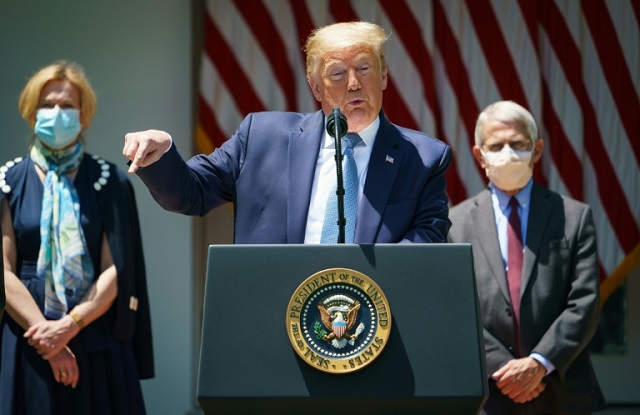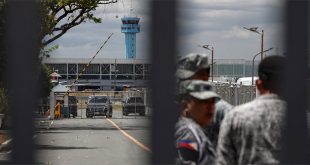
Vienna, Austria | AFP | President Donald Trump voiced hope Friday that a coronavirus vaccine will be available by late 2020, cushioning dire US economic news as parts of Europe re-open despite fears of a second wave of the pandemic.
Several nations have eased restrictions to stem the economic damage from lockdowns, as much of the world learns to live as best it can under the shadow of the disease that has killed more than 306,000 people globally and infected 4.5 million.
While Europe unlocks after reducing the number of new infections, cases continue to soar in other parts of the world as the economic and political fallout grows apace.
The hunt for a vaccine for a disease that the World Health Organization (WHO) says may never disappear has also threatened to become a source of tension between the globe’s haves and have-nots, with trials underway in various countries.
“We are looking to get it by the end of the year if we can, maybe before,” Trump told reporters at the White House as he discussed America’s “Operation Warp Speed” effort in the global race for a vaccine.
The timeline — deemed unrealistic by many experts — is more aggressive than the one-year scenario put forward by European scientists.
Germany, which this month began its slow emergence from confinement, was ready to relaunch its football championship Saturday, although in front of empty stadiums and under draconian health measures.
Russia pushed ahead with plans to ease restrictions despite reporting more than 10,000 new cases, with its football league set to return next month and thousands of people being tested for antibodies to show whether they have had the virus or not.
– Beaches reopening –
Borders and beaches were reopening around Europe after two traumatic months in which life ground to a halt.
Slovenia on Friday became the first European country to open its borders, declaring an end to its coronavirus epidemic despite new infections still being reported.
Latvia, Lithuania and Estonia were creating their own “Baltic bubble” allowing free movement among the three countries, while Austria and Germany were expected to open their shared border.
France called for self-restraint as the country prepared for its first weekend since easing its lockdown Monday, warning that police would break up any large gatherings.
But with the European summer fast approaching, the key tourism industry is trying to salvage something from the wreckage.
French officials have reopened large stretches of beach along the Atlantic coast but only strolling and swimming will be allowed — no sunbathing, and no crowds.
Parasols and sunloungers are starting to appear on coastlines in Italy, one of the countries hardest hit by the pandemic, although reopening is slow and depends on local authorities.
“It moves me to see these sunshades,” said Simone Battistoni, whose family has been running the Bagno Milano beach concession in Cesenatico on Italy’s east coast since 1927.
Austria took an important symbolic step Friday by reopening its restaurants and iconic Viennese cafes.
“We missed it and we’re going to come back as much as possible,” said Fanny and Sophie, 19-year-old students waiting for breakfast at a cafe in the Austrian capital.
Ireland will meanwhile begin to lift its lockdown in coming days while introducing a 14-day quarantine period for new arrivals.
On the other side of the world, Sydney’s bars and restaurants opened their doors to customers Friday as a weeks-long lockdown eased.
“The desire to sit in a place that is not your house with your mates and have a drink is truly overwhelming,” said Chrissy Flanagan, owner of The Sausage Factory, a bistro in Australia’s biggest city.
– US economic woes –
The pressure to ease lockdowns has mounted as the catastrophic economic effects of the virus have become clearer.
In the United States, the world’s worst-affected country with more than 87,000 deaths, industrial production plunged a record 11.2 percent in April, the largest drop in a century.
It was the latest sign of a once-thriving American economy wounded by a crisis that has dug in its teeth and won’t let go.
“May will not be a month of celebration. Nor will June. Nor July. Nor probably the rest of this year,” warned Neil Saunders, managing director of GlobalData Retail.
With 36.5 million Americans — more than 10 percent of the population — left unemployed by the coronavirus disaster, Trump has been keen to ease lockdown measures as he seeks re-election in November.
Some areas are resisting. Lockdown measures in New York City have been extended until May 28 under an executive order signed by state Governor Andrew Cuomo.
US lawmakers were debating a massive, $3 trillion rescue package to help American families and businesses stay afloat.
But the president has also sought to deflect from his government’s handling of the pandemic by ramping up his war of words with Beijing over responsibility for what he has dubbed the “Plague from China,” threatening to cut ties between the two countries.
The virus first emerged in the Chinese city of Wuhan late last year before spreading worldwide, fueled by air travel and a globalized economy.
Europe’s top economy Germany meanwhile tipped into recession, suffering its steepest quarterly contraction since the global financial crisis in 2009.
– ‘Nightmare scenario’ –
The pandemic has also caused political ructions.
Brazil lost its second health minister in a month when Nelson Teich resigned Friday over what an official said was “incompatibility” with right-wing President Jair Bolsonaro’s approach to fighting the country’s spiraling COVID-19 crisis.
Meanwhile the virus continues its global march.
The WHO said Africa could have 231 million people infected and up to 190,000 could die.
There was also concern over the “nightmare scenario” of the discovery of infections in the world’s biggest refugee camp, in Bangladesh, where upwards of a million Rohingya Muslims from neighboring Myanmar live in squalor.
 The Independent Uganda: You get the Truth we Pay the Price
The Independent Uganda: You get the Truth we Pay the Price


